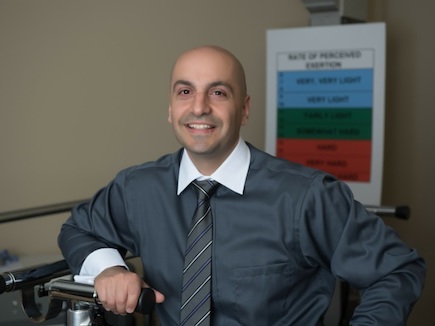Dr. Moh Malek and Dr. Kyle Burghardt earn prestigious manuscript designation
Mitochondria are often referred to as the powerhouse of cells because that is where energy is generated. Thus, disruptions to the mitochondria can negatively influence energy production which causes the cells to function improperly. Studies have shown that aging results in mitochondrial dysfunction in the skeletal muscle. While endurance training leads to various mitochondrial adaptations in the muscle, it relies on the assumption that individuals can ambulate. There are currently no effective treatment methods that address mitochondrial dysfunction caused by diseases or aging in individuals with limited mobility.

Eugene Applebaum College of Pharmacy and Health Sciences Professor of Physical Therapy Moh H. Malek, Associate Professor of Pharmacy Practice Kyle Burghardt, and School of Medicine Professor of Molecular Medicine and Genetics Maik Hüttemann were notified by the Journal of Strength and Conditioning Research (JSCR) that their manuscript titled “Mitochondria Transplantation: Rescuing Innate Muscle Bioenergetic Impairment in a Model of Aging and Exercise Intolerance” was accepted for publication and also selected for the Dr. Gary A. Dudley Memorial Paper.
This Scientific Manuscript Excellence Honor is the highest designation a manuscript can receive from JSCR. Manuscripts go through a second phase of review, above and beyond the usual review process, to be considered for this designation. Since its inception in 2012, only six manuscripts have received this honor. This is Malek and Hüttemann’s second time receiving this designation for their manuscript. The first time was in 2016 for their manuscript related to a compound in dark chocolate, which attenuated the negative effects of muscle disuse.

In the present study, the team used a unique strain of rats that were selectively bred for low running capacity over 40 generations developed by Drs. Steven Britton (University of Michigan) and Lauren Koch (University of Toledo). These rats display traits resembling those found in individuals with metabolic disease. Moreover, these rats have inherently low mitochondrial content in their skeletal muscle and shorter lifespans than their counterparts which were selectively bred for innate high running capacity. The aim of this study was to use mitochondrial transplantation to rejuvenate the hindlimb muscles.
The team used mitochondrial transplantation, which was pioneered by their colleague and co‑author Dr. James McCully, Associate Professor of Surgery at Boston Children's Hospital, Harvard Medical School. McCully has used this technique primarily in cardiac tissue damaged by ischemia-reperfusion injury in both pediatric patients as well as animal models.
“The hallmark discovery of this investigation lies in the substantial upsurge of various regulators of mitochondrial function observed four weeks post-transplantation, with results being muscle fiber-type specific” said Malek.
Burghardt said, “Remarkably, our research also unveiled epigenetic alterations, notably hypomethylation, both at a global level and in specific sites of a critical mitochondrial regulator when comparing the placebo group to the mitochondrial transplantation group.”
Hüttemann summed it up: “This is the first investigation into the efficacy of mitochondrial transplantation in a rodent model featuring both aging and congenital skeletal muscle dysfunction and can potentially become a therapeutic modality that enhances the muscle’s energy production.”
In a follow-up study, Malek, Burghardt and Hüttemann used mitochondrial transplantation to combat aging‑induced mitochondrial dysfunction in skeletal muscle. The manuscript for this second study was accepted for publication by the journal Biomolecules for their Special Issue on Skeletal Muscle Homeostasis and Regeneration.
The team’s research is published in the July issue of the Journal of Strength and Conditioning Research.
An anchor in urban health care
The Eugene Applebaum College of Pharmacy and Health Sciences is built on more than 100 years of tradition and innovation in the heart of Detroit. We have grown deep roots in our city, harnessing its powerhouse hospital systems and community service organizations as vibrant, real-world training grounds for students, with an ongoing focus on social justice in health care.
And our research at all levels – from undergraduates to veteran faculty members – translates into creative solutions for healthier communities.
Wayne State University is a premier urban research institution offering approximately 350 academic programs through 13 schools and colleges to nearly 24,000 students.